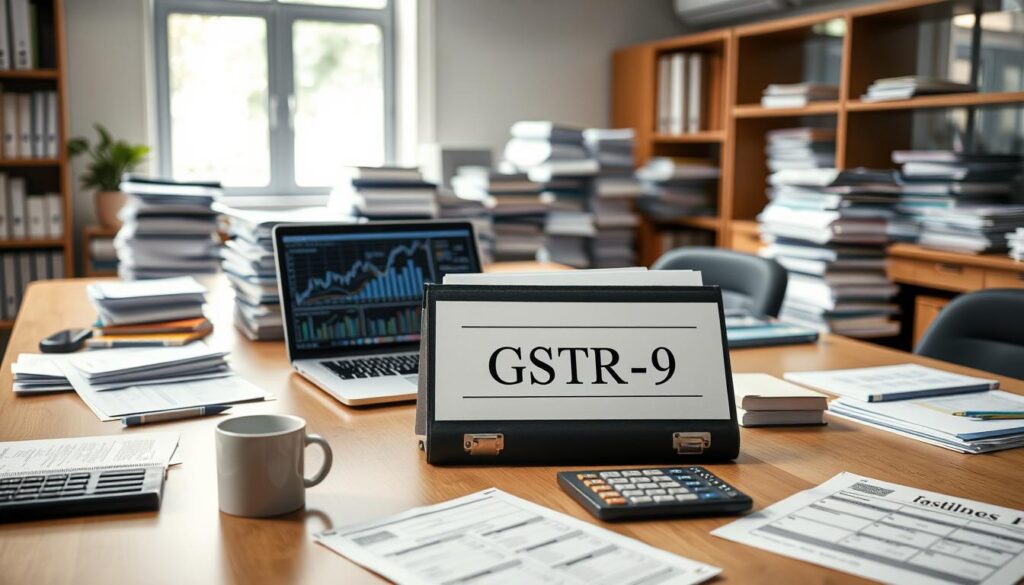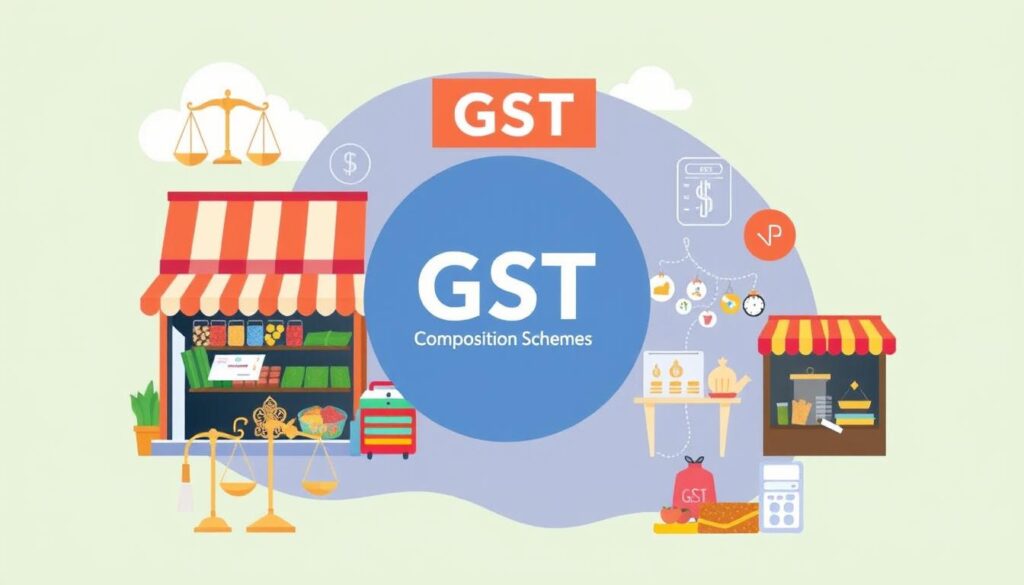Are you ready to navigate the maze of GST annual return filing in India? As the tax landscape evolves, staying compliant is crucial for businesses of all sizes. This comprehensive guide will walk you through the process of What is GST annual return and how to file it for the financial year 2023-24. We’ll ensure you meet all requirements and avoid common pitfalls.
The Goods and Services Tax (GST) annual return is a vital component of tax compliance in India. It consolidates information from monthly or quarterly returns filed throughout the year. This provides a complete picture of your business’s tax position. With the deadline set for December 31, 2024, it’s essential to start preparing early to ensure accurate and timely submission.
Recent changes have simplified the process for some taxpayers. Businesses with an annual turnover up to Rs.2 crores are now exempt from filing GSTR-9 for FY 2023-24. This move aims to reduce the compliance burden on smaller enterprises. For those required to file, understanding GST compliance and mastering GSTR-9 online filing is key to avoiding penalties and ensuring smooth tax filing in India.
In this guide, we’ll cover everything from eligibility criteria and document requirements to step-by-step instructions for navigating the GST portal. We’ll also highlight recent amendments, discuss common errors to avoid, and provide tips for accurate data reconciliation. Whether you’re a seasoned tax professional or a business owner new to GST, this resource will help you confidently tackle your annual return filing obligations.
Overview of GST Annual Return Filing
The Goods and Services Tax (GST) annual return, known as GSTR-9, is a key requirement for businesses in India. It combines data from monthly and quarterly GST returns filed in a year.
Understanding GSTR-9 and its Purpose
The GSTR-9 purpose is to give a detailed overview of a taxpayer’s GST activities for the whole fiscal year. It ensures the accuracy of reported data and checks if businesses follow GST rules.

Eligibility Criteria for Filing GSTR-9
GST annual return eligibility is for regular taxpayers with an annual turnover over ₹2 crore. This includes normal taxpayers, SEZ units, and SEZ developers. Businesses must file GSTR-9 for each GSTIN, even if they were registered for just one day in the year.
Exemptions from Filing GST Annual Return
Some groups are exempt from filing GST annual returns:
- Composition scheme taxpayers
- Casual taxable persons
- Non-resident taxable persons
- Input service distributors
- Businesses with annual turnover up to ₹2 crore (optional filing)
| Annual Turnover | GSTR-9 Filing Requirement |
|---|---|
| Up to ₹2 crore | Optional |
| Above ₹2 crore | Mandatory |
The deadline for filing GSTR-9 is December 31 of the next year. Filing late can lead to penalties, ranging from ₹50 to ₹200 per day. Knowing these rules helps businesses stay compliant and avoid fines.
Preparing for GST Annual Return Filing
GST return preparation is key for businesses in India. It involves collecting important documents and checking data for accurate reports. Let’s look at the main steps for preparing your GST annual return.
Documents and Information Required
To begin your GST return preparation, gather these essential documents:
- GSTR-1 and GSTR-3B returns for the financial year
- GSTR-2A/2B statements
- Purchase and sales invoices
- Tax payment challans
- Refund documents
- Credit and debit notes
Reconciling Data from GSTR-1 and GSTR-3B
Reconciling GSTR-1 and GSTR-3B data is vital. Compare the information in these forms to ensure sales, purchases, and adjustments are consistent. This step helps spot any mistakes and ensures your annual return is correct.
Reviewing Input Tax Credit Claims
Reviewing ITC claims is crucial for accurate reporting. Check your Input Tax Credit claims against GSTR-2A/2B statements and your purchase register. This ensures your ITC claims are valid and you follow GST rules.
| Document | Purpose |
|---|---|
| GSTR-1 | Outward supplies details |
| GSTR-3B | Monthly summary return |
| GSTR-2A/2B | ITC verification |

By following these steps and keeping accurate records, you’ll be ready for your GST annual return. Remember, careful preparation helps avoid mistakes and ensures you follow GST rules.
Step-by-Step Guide to File GSTR-9 Online
Filing your GSTR-9 online is key for GST-registered businesses in India. This guide will help you through the GSTR-9 online filing steps. It covers everything from accessing the GST portal to submitting the GSTR-9 form.
Accessing the GST Portal
First, visit the official GST portal. Use your login details to get in. Then, go to the ‘Services’ tab and choose ‘Returns’. Click on ‘Annual Return’ to start the GSTR-9 filing process.
Filling Out GSTR-9 Form
The GSTR-9 form has six parts. You’ll need to enter details on outward and inward supplies, input tax credit, and tax liability. The form will auto-populate some data from your monthly returns. Make sure to check this information before moving on.
Submitting and Verifying GSTR-9
Once you’ve filled out the form, calculate your liabilities and pay any fees. File your return with a Digital Signature Certificate (DSC) or Electronic Verification Code (EVC). Remember, the deadline for GSTR-9 submission is December 31 of the following financial year.
- Review auto-populated data from GSTR-1 and GSTR-3B
- Enter additional details as required
- Verify all information before final submission
Be aware that late filing can cost Rs. 200 per day, up to Rs. 5,000. Businesses with turnover over Rs. 2 crore must file GSTR-9C. By following these steps and keeping an eye on deadlines, you can meet GST regulations.
Key Sections of GSTR-9 Form
The GSTR-9 form is key for GST compliance. It has 19 tables in 6 parts, covering financial transactions. Let’s look at the main sections taxpayers need to know.
Outward and Inward Supplies
This part deals with outward and inward GST supplies. Businesses must report supplies from July 2017 to March 2018 and later years. It includes financial details like taxpayer info and supply data.
Tax Liability and Payment Details
Taxpayers report tax liability and payments here. It covers taxes paid and refunds claimed in the year. The new GSTR-1 format lets you report consolidated values in some sections.
Input Tax Credit and Reversals
Part 3 of GSTR-9 is about Input Tax Credit (ITC) details. It’s split into three parts. Taxpayers must report ITC availed and reversals accurately, as it affects tax liability.
| GSTR-9 Section | Key Information |
|---|---|
| Outward and Inward Supplies | Consolidated supply details, taxpayer information |
| Tax Liability and Payments | Taxes paid, refunds claimed, consolidated reporting |
| ITC and Reversals | ITC availed, ITC reversals, impact on tax liability |
Knowing these sections is crucial for filing GSTR-9 correctly. Remember, the form can’t be changed after submission. So, make sure all info is right before filing.
What is GST annual return and how to file it?
The GST annual return is a yearly summary of all GST activities. It’s called GSTR-9 and is key for GST compliance. It covers outward and inward supplies, input tax credits, and taxes paid.
Filing GSTR-9 involves several steps:
- Reconcile financial records with GST returns
- Gather necessary documents
- Access the GST portal
- Fill out the GSTR-9 form
- Submit the form by the due date
The deadline for the 2023-24 financial year is December 31, 2024. Remember, GSTR-9 can’t be changed after filing, so it must be accurate.
| Part | Content |
|---|---|
| 1 | Basic taxpayer details |
| 2 | Details of outward supplies |
| 3 | Input tax credit details |
| 4 | Tax payment details |
| 5 | Transactions from previous FY |
| 6 | Other information (demands, refunds, etc.) |
Filing GSTR-9 is required for most GST-registered businesses. Exceptions include those in the Composition Scheme, casual taxable persons, and non-resident taxable persons. Businesses with less than 2 crores in annual turnover can choose not to file.
Delaying GSTR-9 filing leads to penalties of 100 INR per day under CGST and SGST. These penalties cap at 0.25% of total turnover. To avoid penalties, keep records accurate and file on time.
Common Errors to Avoid in GSTR-9 Filing
Filing the GST Annual Return can be tricky. There are many pitfalls that businesses need to watch out for. Knowing these common GSTR-9 filing errors can help avoid costly mistakes and ensure you follow the rules.
Mismatches in Turnover and Tax Liability
A common problem is when the GST turnover reported doesn’t match the actual sales. This usually happens because of wrong sales classification. To avoid this, make sure to check your financial records against your previous returns.
Incorrect Input Tax Credit Claims
Another big issue is making mistakes with Input Tax Credit (ITC) claims. Discrepancies can arise between GSTR-2A/2B and GSTR-9. Always double-check your ITC claims before you file.
| Common ITC Issues | Impact | Solution |
|---|---|---|
| Missing ITC in GSTR-2A/2B | Underreporting of eligible credits | Reconcile with supplier invoices |
| Lack of ITC bifurcation | Inaccurate reporting in GSTR-9 | Maintain detailed ITC records |
| Imported goods ITC reporting | Complications in accurate reporting | Use separate tracking for imported goods |
Omission of Necessary Details
Missing important details can cause big problems. Make sure to include HSN summary and tax paid on advances without invoices. These details are often overlooked but are key for accurate GSTR-9 filing.
By tackling these common errors, businesses can make their GST Annual Return more accurate. This helps avoid penalties or unwanted attention from tax authorities.
Penalties and Late Fees for GSTR-9 Filing
Filing your GST annual return on time is key to avoid late fees and penalties. The fines depend on your business size, with bigger companies paying more.
For businesses with turnover up to ₹5 crore, the daily late fee is ₹50. This is split evenly between CGST and SGST. If your turnover is between ₹5-20 crore, the daily fee jumps to ₹100. Companies with turnover over ₹20 crore face a ₹200 daily fine.
| Turnover | Daily Late Fee | Maximum Penalty |
|---|---|---|
| Up to ₹5 crore | ₹50 | 0.04% of turnover |
| ₹5-20 crore | ₹100 | 0.04% of turnover |
| Above ₹20 crore | ₹200 | 0.5% of turnover |
The maximum penalty is capped at 0.04% of turnover for businesses up to ₹20 crore. For those above, it’s 0.5%. These costs can quickly add up, so filing on time is crucial.
Remember, the deadline for filing GSTR-9 for 2023-24 is December 31, 2024. Keep track of this date and prepare early to avoid penalties.
Recent Amendments in GSTR-9 Format for 2024
The GST annual return process has seen big changes for 2024. These updates aim to make it easier for small businesses to comply. They also encourage filing on time. Let’s look at the main updates and changes for 2024.
One big change is that small businesses with turnover up to ₹2 crore can file GSTR-9 optionally. This makes it easier for small businesses. The Central Board of Indirect Taxes and Customs (CBIC) has also launched an amnesty scheme for late GSTR-9 filings.
This amnesty scheme offers a chance to waive or reduce late fees for past years. It helps businesses that have fallen behind on compliance. The late fee rules have been made simpler based on turnover:
- Up to ₹5 crore: ₹50 per day
- ₹5-20 crore: ₹100 per day
- Above ₹20 crore: ₹200 per day
These updates show the government’s effort to make GST easier and support businesses. The deadline for filing GSTR-9 for FY 2023-24 is still December 31, 2024. It’s important for taxpayers to keep up with these changes to avoid penalties.
Role of GST Reconciliation Statement (GSTR-9C)
The GSTR-9C is key in the GST compliance process. It acts as a link between GSTR-9 and audited financial statements. Businesses with over ₹5 crore in annual turnover must file this form.
Applicability of GSTR-9C Filing
GSTR-9C is needed for those with over ₹5 crore in turnover. It’s important to remember that each GSTIN needs its own form. This can mean filing multiple forms for one PAN.
Preparing for GST Audit and Certification
Getting ready for a GST audit means doing a detailed GSTR-9C reconciliation. The form has two main parts:
- Part I: Basic details
- Part II: Reconciliation of turnover with audited financial statements
Part II has tables for matching gross turnover, taxes paid, and Input Tax Credit (ITC). Taxpayers must report unbilled revenue, unadjusted advances, and more.
Meeting GST certification needs involves self-certification in the GSTR-9C format. The deadline for filing GSTR-9C is December 31 of the year after the financial year. The government can extend this date.
Tips for Accurate and Timely GSTR-9 Filing
Filing GSTR-9 on time is key for businesses in India. The deadline for the 2023-24 financial year is December 31, 2024. Start preparing early to make filing smooth.
Maintaining Proper Records throughout the Year
Good GST record keeping is vital for easy GSTR-9 filing. Organize all invoices, receipts, and financial statements. Regularly check your books against GSTR-2A and GSTR-2B to claim input tax credits accurately.
Using GST Filing Software and Tools
Use GST filing software to make your process easier. These tools can automate reconciliation, saving time and reducing errors. Look for software that:
- Auto-matches invoices
- Sends mismatch alerts
- Integrates with your accounting system
- Updates GST rules in real-time
Seeking Professional Assistance if Needed
For complex reconciliations or large data, consider GST professional services. Experts can guide you through tax laws and ensure compliance. This is crucial for businesses with turnover over Rs. 5 crore, needing to file both GSTR-9 and GSTR-9C.
| Turnover | GSTR-9 Required | GSTR-9C Required |
|---|---|---|
| Up to Rs. 2 crore | Optional | Not Required |
| Rs. 2 crore – Rs. 5 crore | Mandatory | Not Required |
| Above Rs. 5 crore | Mandatory | Mandatory |
Timely filing avoids penalties and builds trust with tax authorities. It also helps in better financial planning for your business.
FAQs on GST Annual Return Filing
Understanding GST annual return filing is key for businesses in India. This section answers common GSTR-9 FAQs to guide you through the process.
Who is required to file GSTR-9?
GSTR-9 is needed for all regular GST-registered businesses with over ₹2 crore in annual sales. Businesses with less than ₹2 crore in sales don’t need to file it. Even if your registration was canceled, you must still file GSTR-9 for the period it was active.
What is the due date for filing GSTR-9?
The deadline for FY 2023-24 is December 31, 2024. Filing on time is important to avoid fines. Businesses with sales up to ₹5 crore pay ₹50 per day late, up to 0.04% of their state turnover. Businesses with higher sales face even higher penalties.
Can GSTR-9 be revised after filing?
Once filed, GSTR-9 cannot be changed. This makes accuracy crucial. Make sure your data, especially Input Tax Credit (ITC) claims, is correct before filing. Any differences between GSTR-3B and GSTR-1 must be fixed before you submit.
| Turnover Range | Late Fee (per day) | Maximum Cap |
|---|---|---|
| Up to ₹5 crore | ₹50 | 0.04% of turnover |
| ₹5 crore to ₹20 crore | ₹100 | 0.04% of turnover |
Remember, GSTR-9 must be filed at the GSTIN level. If you have multiple GST registrations, you need to file a separate return for each. Accurate filing is important for compliance and to avoid problems with tax authorities.
Conclusion
Filing the GST Annual Return is key to staying compliant. GSTR-9, due by December 31st, gives a full view of financial activities. It shows why GST compliance matters and offers big tax management benefits.
The annual return filing is a great tool for businesses to check their tax status. It helps match data from different returns, making sure reports are correct. By carefully preparing and submitting GSTR-9, businesses can avoid fines and keep a good compliance record.
Using smart tax management strategies is crucial for GSTR-9 success. Regularly checking GSTR-1, GSTR-2A, and GSTR-3B helps reduce errors. Using GST software and getting professional help when needed can make GST compliance easier and more accurate.
In short, the GST Annual Return is more than a rule. It’s a chance for businesses to check their financial and tax health. By grasping its value and using strong tax management, businesses can make this duty a powerful tool for financial insight and planning.










